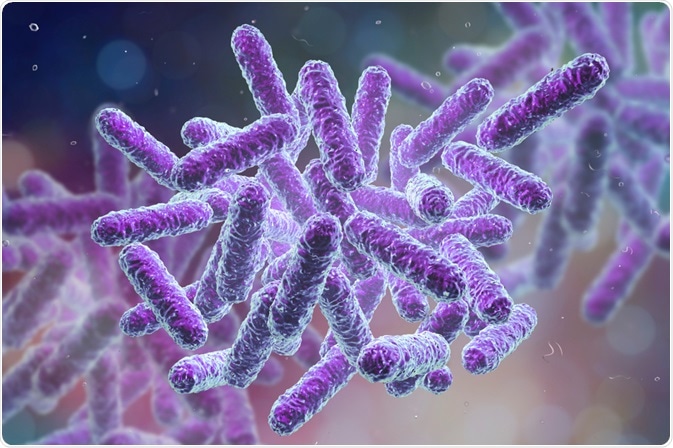What is an Exoenzyme?
Many microorganisms like bacteria, fungi and archaea are unable to uptake certain molecules to use for growth, as only small soluble molecules can pass through their membranes. These microorganisms secrete exoenzymes, which are active outside of cells, in order to breakdown various molecules so they can be more easily ingested.
 Image Credits: Kateryna Kon / Shutterstock.com
Image Credits: Kateryna Kon / Shutterstock.com
What organisms use exoenzymes?
The main type of organisms that utilize exoenzymes are osmotrophs. Osmotrophs are organisms, mainly microorganisms, which take up nutrients from their environment by osmosis. A more specific type of osmotrophy is lysotrophy, which is where exoenzymes are secreted to break down the nutrients in order to be able to absorb them by osmosis.
Exoenzymes are a vital component for the survival of many microorganisms, from fungal exoenzymes within the soil that degrade plant matter, to exoenzymes produced from pathogens to promote their infection.
It can help to compare this system to the digestive system of humans. We need to break down many substances within our stomach through enzymes that are simply too large to digest. Organisms that use exoenzymes function in a similar way, but the enzymes are secreted out of the cell to break down materials before absorption.
In fact, humans do also use exoenzymes, but indirectly. Various species within the microbiome of the human gastrointestinal tract secrete enzymes like amylase and maltase to break down starch into its individual sugars, which are then absorbed. Other examples include cellulases for plant matter and proteases for meat.
The importance of exoenzymes
Exoenzymes have a diverse series of targets and many different types exist to degrade most types of organic matter. Some examples of common exoenzymes include proteases, amylases, xylanases, pectinases, cellulases, chitinases, mannases, ligninases and lipases.
All of these are very important in maintaining the biosphere. Organic plant and animal matter is decomposed in the soil by osmotrophs, through the secretion of various hydrolytic exoenzymes. All the different components of living tissue need to be degraded by different enzymes, so the diversity of organisms within the soil which secrete these enzymes is very important.
They also make new energy sources within the soil more available for plants and other organisms, therefore sending the energy within the biosphere back into a cycle. The organic molecules like proteins, carbohydrates and lipids need to be degraded extracellularly and are vital for growth in many microorganisms and are important energy sources for cellular metabolism.
Exoenzymes within biotechnology
Exoenzymes have a vast area of application within biotechnology, as many industrial processes for the production of food, biofuel and textiles need the degradative properties of exoenzymes for maximum efficiency.
Exoenzymes like amylase, proteases and lipases are useful for the fermentation of food products, such as for beer and wine brewing, dairy production, and for baking. They are a common component of natural and synthetic fermentations which make sugars and other nutrients more available to the culture.
Cellulase, xylanase and amylases are commonly used in the processing of plant material, such as for the paper industry, for the bleaching and recycling of paper.
Another application for exoenzymes within biotechnology is for bioremediation, the clean-up of pollution and toxic substances within the environment using living organisms or products. Many pollutants including polycyclic aromatic hydrocarbons (PAHs) and components of crude oil can be broken down by exoenzymes.
Exoenzymes have also recently shown potential in the breakdown of certain plastics into molecules it can use as an energy source.
Exoenzymes within disease
Many pathogenic species use exoenzymes as a way to increase their virulence and promote their spreading into further tissues within their host. These substances which promote virulence are called virulence factors.
Staphylococcus aureus, for example, uses the exoenzyme hyaluronidase S to break down hyaluronic acid, which is a molecule that helps cells stick together. This allows the bacteria to move through the cells and infect other areas of the body.
Bacillus anthracis, the bacterial species responsible for anthrax, secretes a phospholipase enzyme which can break down the phospholipid membrane of other cells, causing them to rupture. It can use this enzyme to evade the immune system by breaking down the membrane of the phagosome which would normally degrade the bacteria.
Plant pathogens also use exoenzymes as part of their pathogenesis, for example using cellulases and pectinases to break down the cell wall of plant cells for them to gain entry into the plant tissue and proliferate.
Sources
Danso, D., et al. (2019). Plastics: environmental and biotechnological perspectives on microbial degradation. Applied and Environmental Microbiology. https://doi.org/10.1128/AEM.01095-19
Lumen Learning. Virulence Factors of Bacterial and Viral Pathogens. (2020). courses.lumenlearning.com/…/
Richards, T. A., & Talbot, N. J. (2018). Osmotrophy. Current Biology. https://doi.org/10.1016/j.cub.2018.07.069
Riedel, K., & Grunau, A. (2011). Exoenzymes. Encyclopedia of Geobiology. https://doi.org/10.1007/978-1-4020-9212-1_85
Further Reading
- All Microbiology Content
- Gram Negative Bacteria
- Differentiating Between Microbial Species
- Quorum Sensing and Pseudomonas aeruginosa
- Single Cell Microbiology
Last Updated: Jun 19, 2020
Written by
Jack Davis
Jack is a freelance scientific writer with research experience in molecular biology, genetics, human anatomy and physiology, and advanced analytical chemistry. He is also highly knowledgeable about DNA technology, drug analysis, human disease, and biotechnology.
Source: Read Full Article



